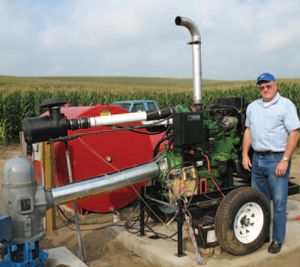 The Renewable Fuels Association has announced the winners of its E85 Flex-Fuel Challenge Sturgis Photo Contest.
The Renewable Fuels Association has announced the winners of its E85 Flex-Fuel Challenge Sturgis Photo Contest.
Tim Gillespie of Cameron Park, California was the Grand Prize winner of a $1,000 gift card to the motorcycle dealership of his choice after submitting his winning photo, “Sturgis Bikes 2009” pictured left. The photo contest was judged based on creativity as well as quality.
 “End of the Ride” photographer Ron Storrm of Wausaukee, Wisconsin was awarded a $100 gift card to the motorcycle dealership of his choice after receiving the Most Voted Award from daily votes submitted to the www.e85challenge.com website. Note the glass of “ethanol” in that photo!
“End of the Ride” photographer Ron Storrm of Wausaukee, Wisconsin was awarded a $100 gift card to the motorcycle dealership of his choice after receiving the Most Voted Award from daily votes submitted to the www.e85challenge.com website. Note the glass of “ethanol” in that photo!
“This contest was about passion for motorcycles, that American pride, and how the combination of an American fuel like ethanol just makes sense,” said Robert White, RFA Director of Market Development. “It was also about education and teaching fellow riders that motorcycles and other small engines can use up to 10% ethanol safely and effectively.”
The RFA Market Development team conducted promotional and advertising events throughout the Legendary Buffalo Chip Campground and town of Sturgis by handing out 10,000 take home palm cards to the rally-goers with information about ethanol, RFA’s consumer website ChooseEthanol.com and the E85 Challenge contest.


 You can’t burn ethanol in a diesel engine. Nope. Just not done. Like mixing oil and water.
You can’t burn ethanol in a diesel engine. Nope. Just not done. Like mixing oil and water.  In this edition of the Domestic Fuel Cast, listen to Bob and Ron as they discuss how this process works and how it will help renewable fuels meet the next round of emission requirements set to kick in in 2011.
In this edition of the Domestic Fuel Cast, listen to Bob and Ron as they discuss how this process works and how it will help renewable fuels meet the next round of emission requirements set to kick in in 2011. The full study, based on the GREET model for corn ethanol emissions, can be downloaded
The full study, based on the GREET model for corn ethanol emissions, can be downloaded 
 “This kind of research has global implications for climate change, energy security and the long-term stability of our local and national economy, particularly as it can help develop the rural infrastructure and jobs we need,” said Barbara Wells, president and CEO of ArborGen.
“This kind of research has global implications for climate change, energy security and the long-term stability of our local and national economy, particularly as it can help develop the rural infrastructure and jobs we need,” said Barbara Wells, president and CEO of ArborGen. This edition of “The Ethanol Report” features comments from Geoff Cooper with the
This edition of “The Ethanol Report” features comments from Geoff Cooper with the 
 Renewed World Energies Corp. is working on turning a 5 acre site into an algae biomass farm that will make biodiesel as well as producing electricity at Georgetown, South Carolina with hopes of being in production by late next year.
Renewed World Energies Corp. is working on turning a 5 acre site into an algae biomass farm that will make biodiesel as well as producing electricity at Georgetown, South Carolina with hopes of being in production by late next year. A new study shows that the ultimate form of solar power could be biodiesel.
A new study shows that the ultimate form of solar power could be biodiesel. Dallas-based
Dallas-based